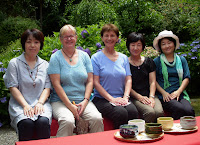Christina the Vampire marched us back and forth across the back end of the Navy base, pausing at Gridley Tunnel, behind the elementary school, and next to the sea wall to share true tales of ghost sightings. This was after we introduced our Japanese friends to Halloween carnival games like bobbing for apples, making caramel corn hands, and groping "human organs" swimming in cold noodles.
 |
| Yuuko the Good Witch |
The American costumes were a bit more eclectic. We had an escaped convict, a sumo wrestler again, a princess, Minnie Mouse, Raggedy Ann, and a somewhat wrinkled Peko-chan.
The bustier Americans favor the wench look this year. Between the Shonan party and this one, I counted at least four slutty barmaids. That flagon hanging from Elena's belt was a nice touch.
You will probably see more than one picture of Elena this year as we seem to be running in the same circles - JAW, Ikebana, and YOSC (the Yokosuka Officer Spouse Club). The same is true for Mimi and Weather Explorer. Don't say I didn't warn you.
You can see I wasn't exaggerating about either the Japanese penchant for black or the exceptional turnout.
At left, Peko-chan is conferring with Weather Explorer on the likelihood of a typhoon arriving just when the Ancient Mariner's flight is scheduled to land at Narita Airport. Everyone else on base watches the Weather Channel but Peko-chan does not know how to turn on the television that takes up an entire wall of her family room. Sigh.
Advised to batten down her hatches, Peko moved a few potted plants to a sheltered area and hoisted a couple of lawn chairs to the screened porch. Then she muttered a few curses in the direction of CDR P for gifting a gas grill and fire pit to the Ancient Mariner (heavy household items are frequently passed from one sailor to another in foreign ports because no one wants to fork over personal funds for exceeding the government's tonnage limits when moving back to the United States).
Peko could not budge that fire pit or gas grill an inch and the cats ignored her pleas for help (they learned that from Matt surely). Not that she had anyplace to store them in any event. She decided to leave them to the elements.
The typhoon was not any stronger than Peko apparently. The firepit and gas grill were still in place after the storm passed. Weight limit or not, these items survived a typhoon and deserve to rust along with us wherever retirement takes us.
















































